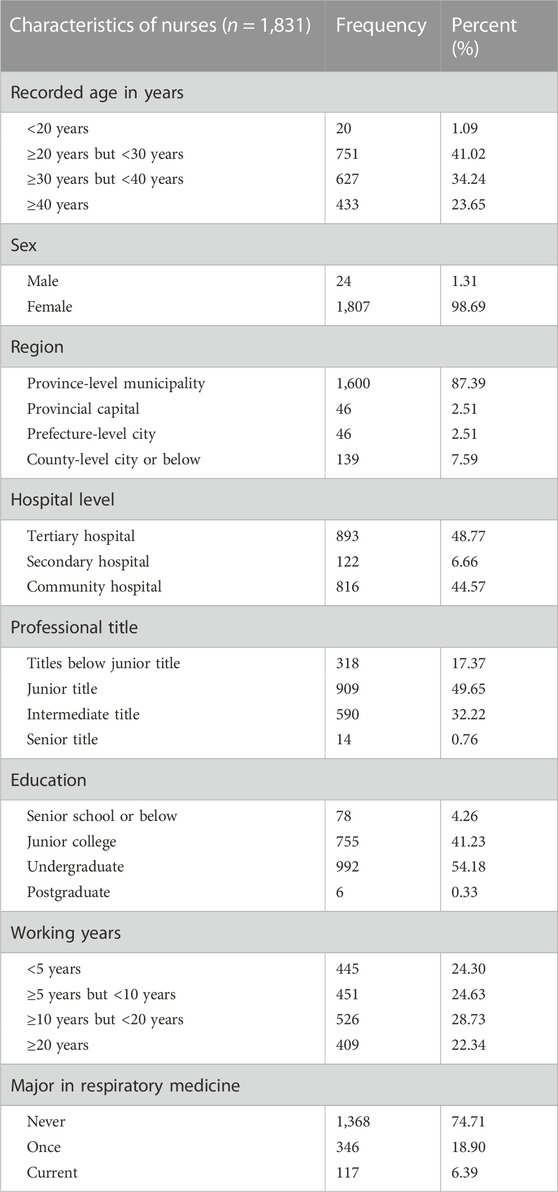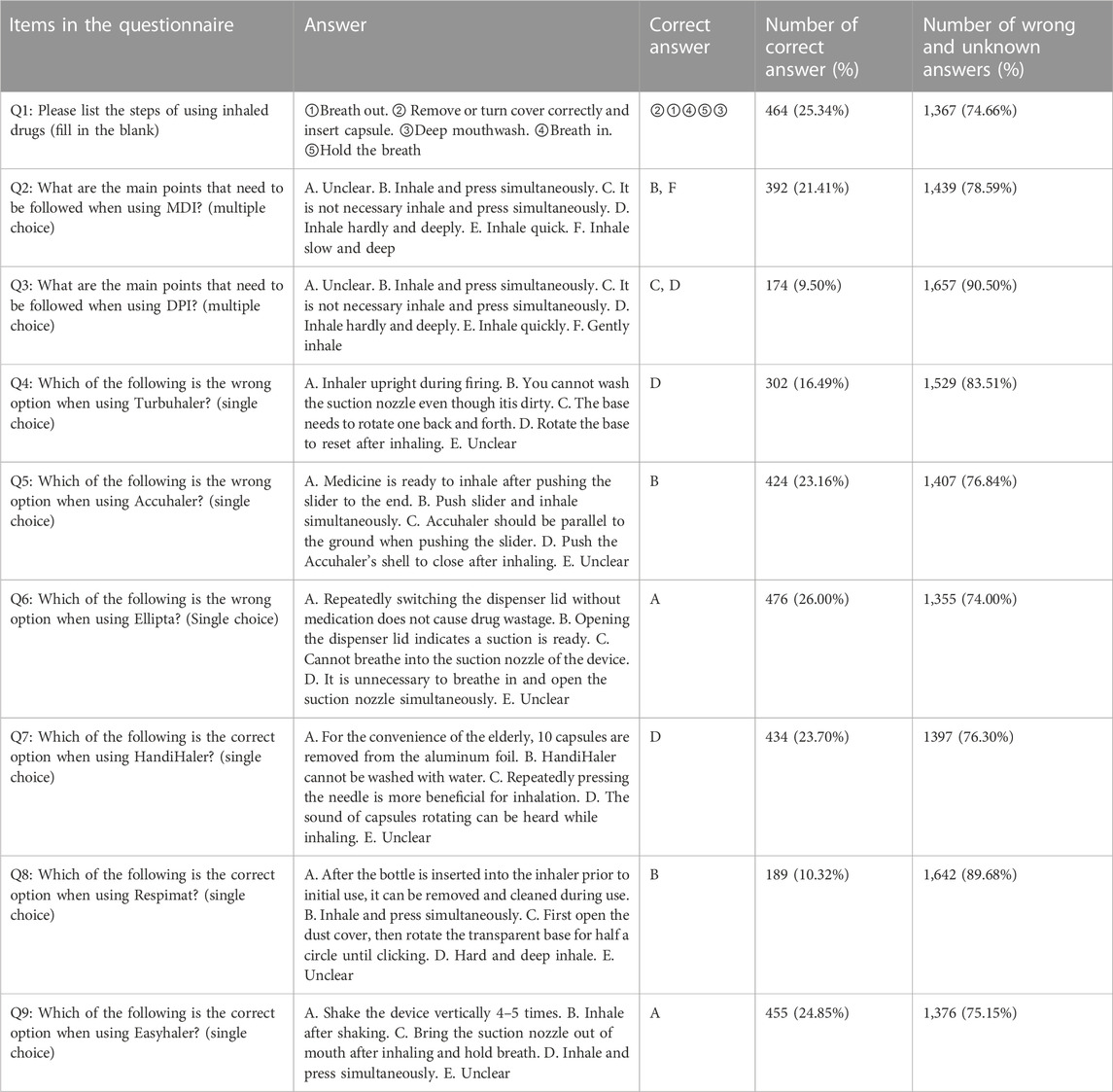- 1Department of Pharmacy, Qingpu Branch of Zhongshan Hospital, Fudan University, Shanghai, China
- 2Department of Nursing, Zhongshan Hospital, Fudan University, Shanghai, China
- 3Department of Pharmacy, Minhang Hospital, Fudan University, Shanghai, China
- 4Department of Pharmacy, Zhongshan Hospital, Fudan University, Shanghai, China
Objective: To understand the level of knowledge about inhaler devices among medical staff.
Methods: This study evaluated the knowledge of inhalation therapy and the use of inhaler devices among nurses in China. We administered a new self-designed online questionnaire to 1,831 nurses. The questionnaire comprised 11 questions, including the storage location of inhaler devices, steps involved in using inhaler devices, and common errors when using various devices.
Results: Among the 1,831 participants, 816(44.57%), 122(6.66%), and 893(48.77%) nurses worked in community, secondary, and tertiary hospitals, respectively. Adequate knowledge of inhaler devices was demonstrated by 20.10%, 8.20%, and 13.10% of nurses working in community, secondary, and tertiary hospitals, respectively. Of the nurses working in community hospitals, 27.70% knew the key points for using inhalers compared to 15.57% in secondary hospitals and 23.18% in tertiary hospitals (p < 0.01). Only 9.50%–26.00% of participants chose correct answers to the 9 questions about the use of inhalers. The accuracy rate of the responses was generally low, and the highest accuracy rate was 26.00%.
Conclusion: Knowledge of inhalation therapy was better among nurses working in community hospitals than among those working in high-level hospitals. This is because of the clearer division of work and higher workload in high-level hospitals. Overall, nurses’ knowledge of inhalation therapy is low. Furthermore, knowledge about inhaler devices should be strengthened among nurses in Chinese hospitals. It is necessary to create training opportunities for nurses in China to increase their awareness and knowledge regarding the management of chronic respiratory diseases.
Introduction
Non-communicable diseases are the leading cause of death worldwide. Chronic respiratory diseases are among the leading causes of morbidity and mortality, and their prevalence is expected to increase in the coming years (World Health Organization, 2007; GBD Chronic Respiratory Disease Collaborators, 2020). In a national cross-sectional study, the overall prevalence of asthma in China was 4.2%, representing 45.7 million Chinese adults (Huang et al., 2019). The overall prevalence of spirometry-defined chronic obstructive pulmonary disease (COPD) in China is 8.6%, accounting for 99.9 million people with COPD (Zhu et al., 2018). In people aged ≥40 years, the prevalence was higher (13.7%) than that in the Chinese national survey conducted in 2007 (8.2%) (Wang et al., 2018).
Although they have become a major public health problem, chronic respiratory diseases are often incompletely treated. The asthma control level improved from 28.7% in 2007–2008 to 39.2% in 2015–2016 (p < 0.01), whereas there was no significant improvement in the rate of peak flow meter usage in the same period (Lin et al., 2018). A national survey across seven provinces found that the regular medical treatment rate of COPD patients was only 7.9% (Zhong et al., 2007). It is crucial to increase awareness of disease and self-management among patients to reduce the disease burden.
Efficient delivery of inhaled medication is essential for the success of chronic respiratory disease therapy. Thus, the correct inhaler technique is crucial as it can impact the efficient delivery of inhaled medication. A poor inhaler technique causes uncontrolled chronic respiratory disease, as failure to effectively deliver the medication to the lungs compromises its clinical efficacy (Manjulakshmi et al., 2019). Several patients with chronic airway disease do not use inhaler devices properly, which contributes to poor disease control (Anna et al., 2021). A previous study showed that non-adherent patients to treatment were almost twice as likely to die compared to adherent patients (Aramís et al., 2021).
To increase clinical efficacy, it is essential to ensure that the patient understands the correct inhaler technique. Studies have shown that patients often get confused about various attributes of different inhalers, and poor technique is common regardless of the device used (Mark et al., 2019; Sarah et al., 2021). Therefore, medical staff play a critical role in educating patients on appropriate inhaler use and ensuring medication adherence. Particularly in China, nurses are responsible for educating patients on using inhaler devices.
Therefore, we surveyed nurses’ knowledge of inhalation therapy and the use of inhaler devices in China. The results of this study provide basic data for recommendations regarding physician education in this arena.
Materials and methods
Selection of participants
A total of 1,831 nurses working in community, secondary, and tertiary hospitals in the Yangtze River Delta Integration Model area, China, were selected for this study. The researcher visited each clinical unit in each hospital and participated in ward meetings. After each meeting, the researcher requested all nurses to fill out an online questionnaire according to their wishes. The nurses participating in the study included personnel from all departments of the hospitals, including the department of respiratory medicine. Finally, the researcher collected the responses to the questionnaire from the web.
Questionnaire respondents were included in the study based on the following criteria: nurses who had worked in public hospitals in the Yangtze River Delta Integration Model area, China; provided informed consent; and voluntarily participated in this study. The exclusion criteria were as follows: personnel on vacation or sick leave and those not willing to participate in the research.
Questionnaire
We designed a new questionnaire to assess the knowledge of inhaler devices. The questionnaire was verified by experts in the fields of respiratory medicine, nursing, and pharmacy. About 5 doctors, 10 pharmacists, and 10 nurses participated in the design of the questionnaire, which was checked and revised repeatedly. The questionnaire consisted of two parts. The first part recorded participants’ age, sex, education level, and contact information. The second part consisted of 11 questions on all types of inhaler devices. The first question concerned the main route of drug administration for asthma and COPD. The second question concerned the storage location of the inhaler devices. The third question asked participants to list the steps involved in using inhaled drugs. The fourth and fifth questions were about the main points in using the metered dose inhaler (MDI) and dry-powder inhaler (DPI), respectively. Questions 6–11 asked participants to identify the wrong options when using Turbuhaler, Accuhaler, Ellipta, HandiHaler, Respimat, and Easyhaler, respectively. The study was conducted online from October 2020 to January 2021.
Statistical analysis
Statistical analyses were performed using SPSS Statistics for Windows, version 21.0 (IBM Corp., Armonk, NY, United States). Socio-demographic characteristics and other categorical variables are presented as frequencies and percentages. The chi-squared test was used to test for differences. The significance level was set at p < 0.05.
Results
Baseline characteristics
Table 1 shows the participants’ sociodemographic characteristics. A total of 751 (41.02%) nurses were aged between 20 and 30 years. Most participants were women (98.69%) and came from province-level municipalities (87.39%). The numbers of nurses working in community, secondary, and tertiary hospitals were 816 (44.57%), 122 (6.66%), and 893 (48.77%), respectively. Most nurses held junior (49.65%) and intermediate (32.22%) positions. Their education level was mainly undergraduate (54.18%) and junior college (41.23%), and most (74.71%) had never worked in the department of respiratory medicine.
Inhaler device storage
As shown in Figure 1, inhaler devices should be stored in a living room cabinet or the bedroom after opening. The percentage of nurses choosing two options was 82.8% and 78.59%, respectively. A total of 50.52% of the nurses chose both options, and 49.48% chose unsuitable storage locations (such as the bathrooms, balconies, kitchens, or refrigerators) for inhaler devices.
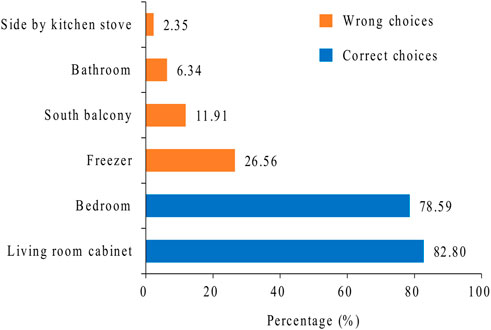
FIGURE 1. Storage place of inhaler devices after opening. The numbers indicate the percentage of the selection. The two blue strips represent the correct choices.
Knowledge of inhaler devices
Figure 2 shows that 1,576 (86.07%) nurses selected inhalation as the main route of drug administration for asthma and COPD, and 13.93% incorrectly selected oral, intravenous, or other routes as the main route of administration.
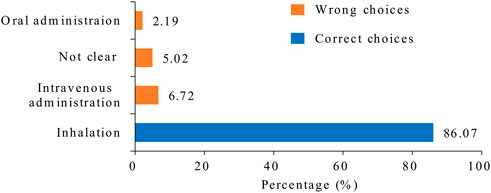
FIGURE 2. Main route of drug administration for asthma and COPD. The numbers indicate the percentage of the selection. The blue strip represents the correct choice. COPD, chronic obstructive pulmonary disease.
Supplementary Table S1 shows the sociodemographic characteristics and knowledge of the inhaler devices. Adequate knowledge of inhaler devices was demonstrated by 20.10%, 8.2%, and 13.1% of nurses working in community, secondary, and tertiary hospitals, respectively, and the difference was statistically significant (p < 0.01) (Figure 3). Only 54 of 117 nurses working in the department of respiratory medicine had adequate knowledge of inhalers. The knowledge of inhaler devices was significantly different between nurses working in the department of respiratory medicine and those who had never worked in the department of respiratory medicine (p < 0.01).
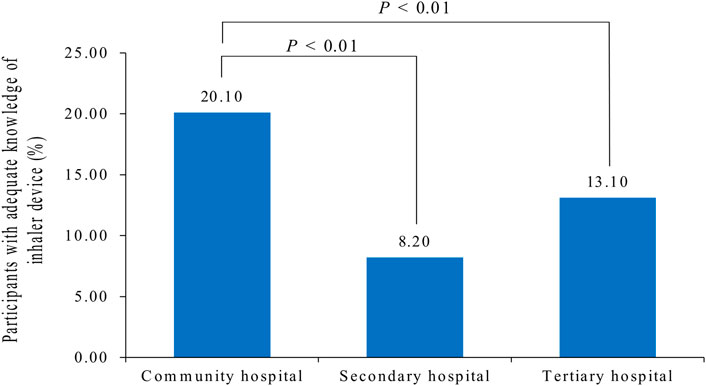
FIGURE 3. Percentage of participants with adequate knowledge of inhaler devices. There are significant differences between community and secondary/tertiary hospitals (p < 0.01).
Technique of inhaler use
As shown in Supplementary Table S2, a slightly higher proportion (27.70%) of nurses in community hospitals knew the operational key points of using inhalers (MDI and DPI) than those in secondary hospitals (15.57%) and tertiary hospitals (23.18%). This difference was statistically significant (Figure 4). The proportions of nurses holding senior (28.57%) and intermediate (26.44%) positions who knew the operational key points were higher than those of nurses with junior (23.32%) and below junior (25.16%) positions.
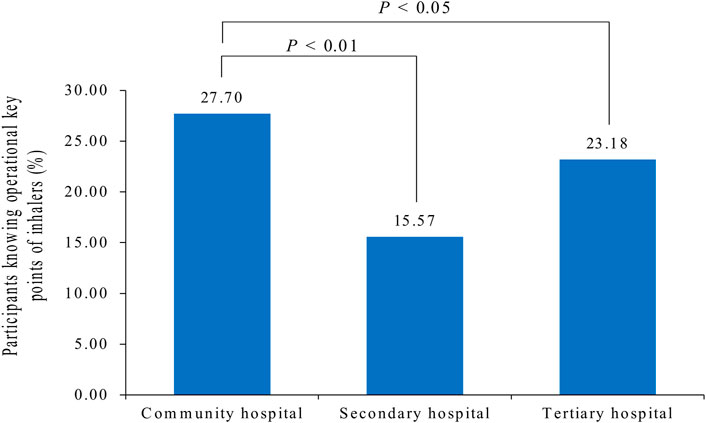
FIGURE 4. Percentage of participants knowing operational key points of inhalers (MDI and DPI). There are significant differences between community and secondary (p < 0.01)/tertiary hospitals (p < 0.05). MDI, metered dose inhaler; DPI, dry-powder inhaler.
As shown in Table 2, the main points of MDI include inhalation and pressing, being synchronized, slow and deep inhalation, and 21.41% of participants chose these two points. DPI does not require hand–mouth synchronization but need inhalation hardly and deeply, and 9.50% of participants chose these two points. Only 114 (6.23%) nurses answered both questions correctly.
Knowledge of inhaler use
As shown in Table 2, there were nine questions about the knowledge of inhaler use. The first question asked participants to list the steps involved in using inhaled drugs. Only 25.34% of the nurses got this correct. The second and third questions pertained to the main points of using MDI and DPI, respectively. Question 6 (Which of the following are the wrong options when using Ellipta?) had the highest percentage of correct answers (26.00%). The question with the lowest rate of correct answers (9.50%) was question 3 (What are the main points that need to be followed when using DPI?). Regarding the use of different inhaler devices in this survey, the maximum number of correct answers was received for Ellipta (26.00%) and the minimum was for Respimat (10.32%).
Discussion
This survey showed that a very high proportion of nurses who worked in hospitals in China lack adequate knowledge of inhaled therapy and related patient education. Overall, 463 (25.29%) nurses had past or current experience in the department of respiratory medicine. Owing to an aging population, an increasing number of elderly patients require medical services in the hospital. Thus, patients with chronic airway disease may be presented to any clinical department, not just the department of respiratory medicine. Therefore, nurses in other clinical departments also need to be trained in using inhalers.
Many patients with chronic airway disease achieve incomplete treatment benefits, due to poor disease control and adherence (Pearce and Fleming, 2018; López-Campos et al., 2019). The reasons for poor disease control and adherence include the type of medication, dosing frequency, patients’ awareness of control, and various patient beliefs and sociocultural and psychological variables (Jordi et al., 2020). Adherence is a major problem for all chronic diseases. However, the inappropriate use of inhalers poses additional difficulties in patients with asthma and COPD. Several patients do not receive appropriate inhaler training, and their inhaler techniques are not monitored. The main reason for the current situation is that physicians and nurses who prescribe or supervise these inhalers have poor knowledge and skills regarding their use (Bamidele et al., 2018; Maepa et al., 2019). Studies have shown that patients with good adherence have a 44% lower rate of severe exacerbation (Jose and Oliver, 2019).
Hospitals in China are divided into three levels according to the National Health Commission of China: community, secondary, and tertiary hospitals. The national roadmap, the Healthy China 2030 plan (CPC, 2016), highlights the important role of primary healthcare in substantially strengthening chronic disease management (Gao et al., 2021). In China, especially in the community hospital, nurses usually teach patients about inhaler devices. Our study found that 44.57% of the participants worked in community hospitals. Moreover, they had better knowledge of inhaler devices than nurses in secondary and tertiary hospitals. The number of nurses who knew at least two essential steps in inhaler use was higher in community hospitals than that in secondary and tertiary hospitals. This result is consistent with Chinese national conditions. This may be because the division of labor in secondary and tertiary hospitals in China is relatively fine, leading to a lack of knowledge among non-respiratory nurses. Nurses holding junior and below positions often undertake more clinical work, while nurses holding intermediate and senior positions undertake some management work. It is suggested that nurses from non-respiratory wards, such as the department of cardiology and geriatric medicine, be trained in the department of respiratory medicine to provide inhalation education, to ensure good education for patients with non-respiratory wards, and to gain medication safety.
Our questionnaire differed from other questionnaires where it focused on the errors that patients tend to make when using various inhalation devices. Our study included the important points of commonly used inhalers. It was more friendly and concise, and we easily obtained the cooperation of the responders. In contrast, other questionnaires are more complicated, assess only the types of inhalers, and no specific device is evaluated. Regarding the composite variable, general knowledge of inhaled therapy, we pooled the answers to the questions about the use of inhaler devices; only 9.50%–26.00% of participants in our study responded correctly to the 9 questions. Our results indicate that the nurses’ knowledge of inhalers is not sufficient for effective communication with patients. This finding is similar to the results of other studies. Hajed evaluated that the healthcare providers’ knowledge of aerosol drug delivery is completely inadequate. There is an urgent need to introduce an aerosol drug delivery educational package in the curricula (Al-Otaibi, 2020). Another study showed that the general level of knowledge regarding the use of inhalation devices is low among nurses working in this field in Spain (Jordi et al., 2016). Vinita et al. (2021) reported that even nurses in the department of respiratory medicine did not fully master all inhaler devices. This study revealed a strong correlation between the number of inhalers prescribed in the previous year and nurses’ inhaler device scores. Our previous study demonstrated that inhaler training can increase the patients’ peak inhalation flow rate and improve their ability to use DPIs (Hua et al., 2021). Thus, educating healthcare workers is vital for teaching patients about the correct use of inhaler devices.
In this study, we identified that there is a lack of knowledge about inhaler devices among nurses in China. Based on the current situation, it is necessary to create training opportunities for nurses to increase their knowledge of inhaler devices. In addition, we should establish a team of professionals to regularly measure nurses' knowledge of inhaler devices. Regular assessment and ongoing education on the correct inhaler technique for respiratory nurses are necessary to optimize device usage by nurses. Finally, related institutional improvements are important. Chronic diseases require long-term management, including patient self-management based on accurate knowledge of drug use and regular review at the hospital. The hierarchical medical system in China is a good way to facilitate the medical treatment of patients with chronic diseases in community hospitals. Many patients with chronic diseases receive medication guidance in community hospitals. As some tests are only performed in tertiary hospitals, nurses in tertiary hospitals must master the key points of medication for chronic diseases.
This survey is the first domestic exploration of the problem of medication errors in inhalation preparations in China. It is a comprehensive survey of nurses in community, secondary, and tertiary hospitals. However, this study had some limitations. First, all participants were nurses. Second, participants were not screened, and nurses not working in the department of respiratory medicine or who have not been exposed to inhaler devices may not have sufficient knowledge in this regard. Third, the questionnaire was completed once without repeated verification. It may be necessary to expand the inclusion criteria to include physicians and pharmacists in future studies, so that more accurate and relevant data are obtained.
In conclusion, nurses lack knowledge of inhaler devices. Nurses working in community hospitals had better knowledge about handling of inhaler devices than those in secondary and tertiary hospitals. Therefore, sufficient professional training focused on inhaler devices is urgently needed. Based on the current situation in China, we also proposed specific measures to solve this problem. Although the findings of our study are preliminary, they may provide a possible explanation for the current issues with inhaler use.
Data availability statement
The original contributions presented in the study are included in the article/Supplementary Material; further inquiries can be directed to the corresponding author.
Ethics statement
Written informed consent was obtained from the individual(s) for the publication of any potentially identifiable images or data included in this article.
Author contributions
XY is the guarantor of the entire manuscript. NX, XY, and ZZ contributed to the study conception and design, critical revision of the manuscript for important intellectual content, and final approval of the version to be published. QY and ML contributed to data acquisition, analysis, and interpretation.
Funding
This study was supported by the Research Funds of Shanghai Key Specialty of Clinical Pharmacy Project (2018 No. 9).
Conflict of interest
The authors declare that the research was conducted in the absence of any commercial or financial relationships that could be construed as a potential conflict of interest.
Publisher’s note
All claims expressed in this article are solely those of the authors and do not necessarily represent those of their affiliated organizations, or those of the publisher, the editors, and the reviewers. Any product that may be evaluated in this article, or claim that may be made by its manufacturer, is not guaranteed or endorsed by the publisher.
Supplementary material
The Supplementary Material for this article can be found online at: https://www.frontiersin.org/articles/10.3389/fphar.2023.1152069/full#supplementary-material
References
Al-Otaibi, H. M. (2020). Evaluation of health-care providers’ knowledge in the science of aerosol drug delivery: Educational sessions are necessary. J. Fam. Community Med. 27 (1), 62–66. doi:10.4103/jfcm.JFCM_138_19
Anna, V., Paulien van der, W., Barbara, P., and Lies, L. (2021). Determinants of poor inhaler technique and poor therapy adherence in obstructive lung diseases: A cross-sectional study in community pharmacies. BMJ Open Respir. Res. 8 (1), e000823. doi:10.1136/bmjresp-2020-000823
Aramís, T. A. M., Charleston, R. P., Antônio, C. M. L., Lindemberg, A. C., Gisélia, S. S., and Eduardo, M. N. (2021). Evidence of the association between adherence to treatment and mortality among patients with COPD monitored at a public disease management program in Brazil. J. Bras. Pneumol. 48 (1), e20210120. doi:10.36416/1806-3756/e20210120
Bamidele, O. A., Ayodeji, M. A., Olayinka, S. I., Daniel, O. O., Olubukola, O. A., and Gregory, E. E. (2018). Knowledge of spacer device, peak flow meter and inhaler technique (MDIs) among health care providers: An evaluation of doctors and nurses. Ghana Med. J. 52 (1), 15–21. doi:10.4314/gmj.v52i1.4
CPC (2016). The plan for “Healthy China 2030”. Available at: http://www.gov.cn/xinwen/2016-10/25/content_5124174.html (Accessed March 15, 2022).
Gao, C., Xu, J., Liu, Y., and Yang, Y. (2021). Nutrition policy and Healthy China 2030 building. Eur. J. Clin. Nutr. 75 (2), 238–246. doi:10.1038/s41430-020-00765-6
GBD Chronic Respiratory Disease Collaborators (2020). Prevalence and attributable health burden of chronic respiratory diseases, 1990-2017: A systematic analysis for the global burden of disease study 2017. Lancet Respir. Med. 8 (6), 585–596. doi:10.1016/S2213-2600(20)30105-3
Hua, J., Ye, X., Du, C., Xie, N., Zhang, J., Li, M., et al. (2021). Optimizing inhalation therapy in the aspect of peak inhalation flow rate in patients with chronic obstructive pulmonary disease or asthma. BMC Pulm. Med. 21 (1), 302. doi:10.1186/s12890-021-01674-5
Huang, K., Yang, T., Xu, J., Yang, L., Zhao, J., Zhang, X., et al. (2019). Prevalence, risk factors, and management of asthma in China: A national cross-sectional study. Lancet 394 (10196), 407–418. doi:10.1016/S0140-6736(19)31147-X
Jordi, G. D., David, D. P., Carme, H., Roberto, C., et al. (2020). Study to evaluate satisfaction with the inhalation device used by patients with asthma or chronic obstructive pulmonary disease and the association with adherence and disease control. J. Aerosol Med. Pulm. Drug Deliv. 33 (3), 153–160. doi:10.1089/jamp.2019.1541
Jordi, G., Pere, R., Carme, H., Montserrat, T., Meritxell, P., Ma, J. F., et al. (2016). Knowledge and attitudes of nurses in Spain about inhaled therapy: Results of a national survey. J. Aerosol Med. Pulm. Drug Deliv. 29 (1), 86–93. doi:10.1089/jamp.2014.1198
Jose, R. J., and Oliver, A. N. (2019). The importance of inhaler adherence to prevent COPD exacerbations. Med. Sci. (Basel) 7 (4), 54. doi:10.3390/medsci7040054
Lin, J. T., Wang, W. Q., Zhou, X., Yin, K. S., Liu, C. T., Wang, C. Z., et al. (2018). Trends of asthma control, disease management and perception in China. Zhonghua Jie He He Hu Xi Za Zhi 41 (3), 191–195. doi:10.3760/cma.j.issn.1001-0939.2018.03.009
López-Campos, J. L., Quintana Gallego, E., and Carrasco Hernández, L. (2019). Status of and strategies for improving adherence to COPD treatment. Int. J. Chron. Obstruct Pulmon Dis. 14, 1503–1515. doi:10.2147/COPD.S170848
Maepa, H. M., Wong, M. L., and Menezes, C. N. (2019). Evaluation of the knowledge and correct use of metered-dose inhalers by healthcare professionals and medical students in Gauteng Province. Afr. J. Thorac. Crit. Care Med. 25(3), 111. doi:10.7196/AJTCCM.2019.v25i3.003
Manjulakshmi, P., Kadhiravan, T., Manju, R., and Gitanjali, B. (2019). Inadequate inhaler technique, an everlasting problem, is associated with poor disease control - a cross sectional study. Adv. Respir. Med. 87 (4), 217–225. doi:10.5603/ARM.a2019.0021
Mark, L. L., Will, C., José, L. I. A., Claus, K., Federico, L., Lauri, L., et al. (2019). Understanding Dry powder inhalers: Key technical and patient preference attributes. Adv. Ther. 36 (10), 2547–2557. doi:10.1007/s12325-019-01066-6
Pearce, C. J., and Fleming, L. (2018). Adherence to medication in children and adolescents with asthma: Methods for monitoring and intervention. Expert Rev. Clin. Immunol. 14 (12), 1055–1063. doi:10.1080/1744666X.2018.1532290
Sarah, A. B., Vicky, K., David, B. P., and Sinthia, B. A. (2021). Identifying patients at risk of poor asthma outcomes associated with making inhaler technique errors. J. Asthma 58 (7), 967–978. doi:10.1080/02770903.2020.1742353
Vinita, S., Jin-Gun, C., Tracy, S., John, W., and Mary, R. (2021). Confidence of nurses with inhaler device education and competency of device use in a specialised respiratory inpatient unit. Chronic Respir. Dis. 18, 14799731211002241. doi:10.1177/14799731211002241
Wang, C., Xu, J., Yang, L., Xu, Y., Zhang, X., Bai, C., et al. (2018). Prevalence and risk factors of chronic obstructive pulmonary disease in China (the China pulmonary health [CPH] study): A national cross-sectional study. Lancet 391 (1013), 1706–1717. doi:10.1016/S0140-6736(18)30841-9
World Health Organization (2007). Global surveillance, prevention and control of chronic respiratory diseases: A comprehensive approach. Available at: http://www.who.int/gard/publications/GARD_Manual/en/index.html (Accessed March 15, 2022).
Zhong, N., Wang, C., Yao, W., Chen, P., Kang, J., Huang, S., et al. (2007). Prevalence of chronic obstructive pulmonary disease in China: A large, population-based survey. Am. J. Respir. Crit. Care Med. 176, 753–760. doi:10.1164/rccm.200612-1749OC
Keywords: inhaler devices, chronic disease, community hospital, nurses, knowledge of inhalation therapy
Citation: Xie N, Zheng Z, Yang Q, Li M and Ye X (2023) Nurses in China lack knowledge of inhaler devices: A cross-sectional study. Front. Pharmacol. 14:1152069. doi: 10.3389/fphar.2023.1152069
Received: 27 January 2023; Accepted: 23 March 2023;
Published: 07 April 2023.
Edited by:
Hao Li, Shanghai Jiao Tong University, ChinaReviewed by:
Yina Zhang, Helios Amper-Klinikum Dachau, GermanyRaffaele Campisi, Azienda Ospedaliera Universitaria Policlinico G. Rodolico-San Marco, Italy
Yanyan Zhang, Guizhou Medical University, China
Copyright © 2023 Xie, Zheng, Yang, Li and Ye. This is an open-access article distributed under the terms of the Creative Commons Attribution License (CC BY). The use, distribution or reproduction in other forums is permitted, provided the original author(s) and the copyright owner(s) are credited and that the original publication in this journal is cited, in accordance with accepted academic practice. No use, distribution or reproduction is permitted which does not comply with these terms.
*Correspondence: Xiaofen Ye, eWUueGlhb2ZlbkB6cy1ob3NwaXRhbC5zaC5jbg==
†These authors have contributed equally to this work and share first authorship
 Ning Xie
Ning Xie Zheng Zheng2†
Zheng Zheng2†